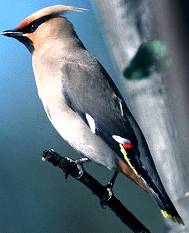Back to the Newsletter Contents and Home
page
Waxwing Irruption 2004
by Jim Pewtress
 The Waxwing is a winter visitor
to northern and eastern Britain with numbers varying from a few dozen in most years to several thousand
in an “irruption” year. Numbers arriving in Britain are determined by the crop of Rowan berries
in Scandinavia. If there is a bumper berry crop, many Waxwings survive the winter so the breeding population
increases dramatically. However, the Rowan trees are unable to produce a large berry crop in two successive
years so at the end of the summer there are exceptionally high numbers of Waxwings but small quantities
of berries. The Waxwings turn to ornamental plants and therefore invade towns and villages, devouring
every berry in sight before moving on to the next town or even the next country.
The Waxwing is a winter visitor
to northern and eastern Britain with numbers varying from a few dozen in most years to several thousand
in an “irruption” year. Numbers arriving in Britain are determined by the crop of Rowan berries
in Scandinavia. If there is a bumper berry crop, many Waxwings survive the winter so the breeding population
increases dramatically. However, the Rowan trees are unable to produce a large berry crop in two successive
years so at the end of the summer there are exceptionally high numbers of Waxwings but small quantities
of berries. The Waxwings turn to ornamental plants and therefore invade towns and villages, devouring
every berry in sight before moving on to the next town or even the next country.
The last time there was an influx of Waxwings in to Britain was in the winter of
1995/96. There was a hint of the latest influx when reports came from Scandinavia
that there were masses of Waxwings in southern Sweden during October. Flocks of
200-300 began to appear in Scotland in the latter half of October and 12 were at
Pickering on 31st. By early November 1020 were at Inverness, 100 had reached Outstand
in Norfolk and the flock at Pickering had increased to 60-70. A flock of 40-50 were
in gardens at the back of West End, Kirkbymoorside throughout the month.
There was a further influx in late November in Scotland with 1800 at Kincorth on
21st, 1000 in Glasgow on 22nd, 1200 at Aberdeen and 700 in Edinburgh on 28th and
1000 at the Bridge of Don on 30th. Spreading south there were 400 at Corbridge,
600 at Dalston, Cumbria and Jarrow. 120 were reported in Norwich.
The first two weeks in December saw 300 at Blaydon and Jarrow and on 5th December
70 were seen in West End with 500 at Howkeld. 200-400 had reached Northern Ireland
and 200 were in Dublin. Small parties were in the Kirkbymoorside area and Slingsby
on 13th, 14th and 24th.
Flocks have been reported from throughout Europe and at the present time (early
February) there are approx. 500 in Italy, the first there since 1989.
Back to the Newsletter Contents and Home
page
 The Waxwing is a winter visitor
to northern and eastern Britain with numbers varying from a few dozen in most years to several thousand
in an “irruption” year. Numbers arriving in Britain are determined by the crop of Rowan berries
in Scandinavia. If there is a bumper berry crop, many Waxwings survive the winter so the breeding population
increases dramatically. However, the Rowan trees are unable to produce a large berry crop in two successive
years so at the end of the summer there are exceptionally high numbers of Waxwings but small quantities
of berries. The Waxwings turn to ornamental plants and therefore invade towns and villages, devouring
every berry in sight before moving on to the next town or even the next country.
The Waxwing is a winter visitor
to northern and eastern Britain with numbers varying from a few dozen in most years to several thousand
in an “irruption” year. Numbers arriving in Britain are determined by the crop of Rowan berries
in Scandinavia. If there is a bumper berry crop, many Waxwings survive the winter so the breeding population
increases dramatically. However, the Rowan trees are unable to produce a large berry crop in two successive
years so at the end of the summer there are exceptionally high numbers of Waxwings but small quantities
of berries. The Waxwings turn to ornamental plants and therefore invade towns and villages, devouring
every berry in sight before moving on to the next town or even the next country.